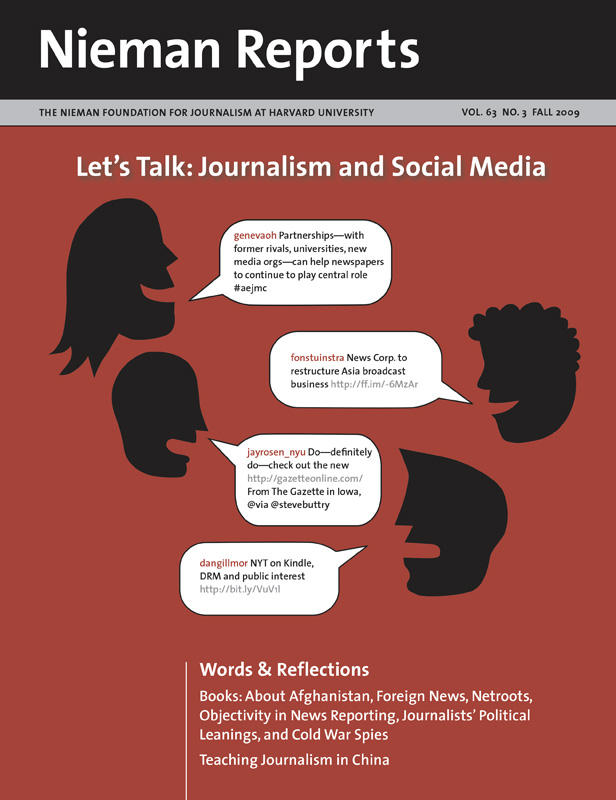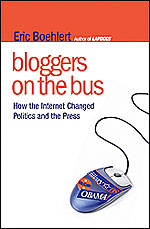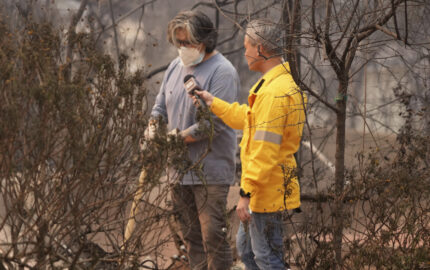George W. Bush’s presidency launched a million liberal bloggers. As Bush and Vice President Dick Cheney pursued many dubious projects—the Iraq War, “harsh interrogations,” warrantless eavesdropping, excessive secrecy, retrograde approaches to climate change and emergency management—Democrats, liberals and former political agnostics took to the ever-expanding blogosphere to express their outrage. Over time, the liberal blogosphere became a force to be reckoned with, incorporating diverse voices and arguments, reporting and some investigative journalism, vast fundraising and organizing capabilities, and influential online communities.
The netroots—a catchy combination of Internet and grassroots—is the largest and most cohesive segment of this political movement, and it emerged out of Howard Dean’s 2004 presidential campaign. Its organizational DNA, and even more its basic sensibility, proved instrumental in Barack Obama’s 2008 victory. Netroots bloggers were unapologetically liberal and skeptical (and, at times, contemptuous) toward the ideological compromises Bill Clinton made to get support. Yet, they were pragmatic about winning elections and passing legislation.
Journalist Eric Boehlert, a senior fellow at the liberal watchdog group Media Matters for America, spent much of 2008 hanging out with influential netroots bloggers and others who, through their use of various digital media, had an impact on the campaign. He profiles them in “bloggers on the bus: How the Internet Changed Politics and the Press,” a book self-consciously modeled on “The Boys on the Bus,” Timothy Crouse’s urtext on modern campaign coverage about the 1972 presidential race.
Crouse’s book is justly influential, portraying for the first time the odd customs of the modern media bubble. Interestingly, Boehlert’s effort to take us inside the online bubble bears only a superficial resemblance. Crouse’s insider journalists belonged to a professional clan; Boehlert’s book is about outsiders, most with little or no political experience. Many of the personalities will be familiar to those who read political blogs or followed the 2008 campaign: influential bloggers Atrios, Digby, Jane Hamsher, and Glenn Greenwald; Internet mogul Arianna Huffington; Mayhill Fowler, The Huffington Post’s citizen journalist who reported Obama’s remarks at a fundraiser on how rural voters “cling to” religion and guns. Some make a living on the Internet; others were randomly drawn into the campaign orbit and then swept along, doing what they do for love or enjoyment. Operating in the outermost reaches of the campaigns and the daily news cycle, they managed to break into that once-impenetrable world.
Expanding the Conversation
Presidential campaigns have limited numbers of players: the candidates, consultants and pollsters trying to influence the voting public and the reporters and producers who follow them. The Internet creates the potential for more dynamic—and unpredictable—conversations between campaigns and the public.
One memorable moment occurred in March 2007, when a video, “Vote Different,” was posted anonymously to YouTube. It was a tweaked version of Apple’s “1984” commercial, in which numb, gray-clad masses listen to an authority figure drone on from a giant screen, until a runner bursts in, hurls a hammer, and smashes it. In this version, Hillary Clinton had replaced Big Brother. The clip ended with a link to Obama’s Web site. At the time Clinton was a strong frontrunner, and this video captured some of the incipient dissatisfaction with her campaign. And it went viral—moving first through the netroots network, then into the establishment media.
Then, traditional campaign etiquette kicked in. Who was the creator? Was he or she working for Obama? Was Obama attacking Clinton? It turned out to be a 33-year-old computer graphics tech named Philip de Vellis. He’d done the clip on his own but was a contract worker for a media firm employed by the Obama campaign. He was outed and promptly fired, though said he had no regrets.
This awkward insider-outsider dynamic is a recurring theme. Boehlert devotes a chapter to Joe Anthony, a 28-year-old paralegal who set up a MySpace page for Obama and carefully built it into an important and popular portal for the campaign, with its approval—until campaign officials exercised their legal rights and took over the site, locking him out in the process. Anthony was left angry and disillusioned about politics.
A story like this one raises an interesting question: How should campaigns handle the work of volunteers when they build something useful online? But this is hardly the kind of revolutionary change the book purports to be documenting. In fact, it underlines how fleeting the accomplishments of many of Boehlert’s subjects are. They involve feeding frenzies of one kind or another, in which the establishment media briefly go nuts over something that appears online. But these don’t last, and we don’t get a sense that they really change the electoral fundamentals. Meanwhile, liberal bloggers spend a lot of time warring among themselves about whether Obama supporters’ attacks on Clinton were sexist or merely nasty politics. (Boehlert unconvincingly sides with the “sexist” camp.)
The Internet and Politics
So it’s hard to tell, at least from the format that Boehlert chose to tell his story and despite his ambitious-sounding subtitle, precisely how the Internet is changing politics and the press. And it obviously is. For one, bloggers provide a compelling critique of traditional media coverage that has begun to have an impact. Another big change is the advent of the expert blogger, exemplified by Boehlert’s writing about lawyer Glenn Greenwald, whose blogging on the political maneuvering over wireless eavesdropping laws explained what was happening far better than any journalist. Inexplicably missing from “bloggers on the bus,” though, is Nate Silver, writing at fivethirtyeight.com, named for the number of electoral votes. His was the breakout Web site of campaign 2008. With his innovative crunching of poll numbers and dispassionate analysis of the daily trend lines, Silver’s words became required—and obsessive—reading for the entire campaign world, insiders and outsiders alike.
But here’s the intrinsic problem in evaluating the Internet’s impact on politics through Boehlert’s character-based stories: The Web is the exact opposite of the self-contained world of Crouse’s bus. Individuals are important, but the broader panorama is more so. The Web is, after all, everywhere in a way even Walter Cronkite never could be.
For instance, I’d like to know how influential bloggers really are. Polling shows that the vast bulk of the American electorate doesn’t read political blogs and votes a party line. How many readers do the netroots, along with sites such as The Huffington Post, have? Who are they? How much influence did netroots and other liberal bloggers have on voting itself, and is that influence felt mostly among Democratic Party faithful or the less-differentiated center of the political spectrum? How does the reach of liberal voices compare with that of their conservative/Republican counterparts? (Boehlert contends that the conservative blogosphere hasn’t kept pace in influence or technical sophistication.)
The 2008 campaign made it clear that the old model, in which journalists interpret campaign events for the masses, is kaput, and that the new model is more chaotic and interactive. But in other ways, it didn’t change much at all: Boehlert writes that as the Obama campaign built its own online movement, it mostly ignored the netroots. Campaigns, after all, still aim to put out a consistent and controlled message. We’ll have to wait to see if 2008’s changes are truly the first rumblings of a bottom-up revolution.
John McQuaid, a Washington writer, covered two presidential campaigns. He is the coauthor of “Path of Destruction: The Devastation of New Orleans and the Coming Age of Superstorms.” He blogs at johnmcquaid.com/blog.
The netroots—a catchy combination of Internet and grassroots—is the largest and most cohesive segment of this political movement, and it emerged out of Howard Dean’s 2004 presidential campaign. Its organizational DNA, and even more its basic sensibility, proved instrumental in Barack Obama’s 2008 victory. Netroots bloggers were unapologetically liberal and skeptical (and, at times, contemptuous) toward the ideological compromises Bill Clinton made to get support. Yet, they were pragmatic about winning elections and passing legislation.
Journalist Eric Boehlert, a senior fellow at the liberal watchdog group Media Matters for America, spent much of 2008 hanging out with influential netroots bloggers and others who, through their use of various digital media, had an impact on the campaign. He profiles them in “bloggers on the bus: How the Internet Changed Politics and the Press,” a book self-consciously modeled on “The Boys on the Bus,” Timothy Crouse’s urtext on modern campaign coverage about the 1972 presidential race.
Crouse’s book is justly influential, portraying for the first time the odd customs of the modern media bubble. Interestingly, Boehlert’s effort to take us inside the online bubble bears only a superficial resemblance. Crouse’s insider journalists belonged to a professional clan; Boehlert’s book is about outsiders, most with little or no political experience. Many of the personalities will be familiar to those who read political blogs or followed the 2008 campaign: influential bloggers Atrios, Digby, Jane Hamsher, and Glenn Greenwald; Internet mogul Arianna Huffington; Mayhill Fowler, The Huffington Post’s citizen journalist who reported Obama’s remarks at a fundraiser on how rural voters “cling to” religion and guns. Some make a living on the Internet; others were randomly drawn into the campaign orbit and then swept along, doing what they do for love or enjoyment. Operating in the outermost reaches of the campaigns and the daily news cycle, they managed to break into that once-impenetrable world.
Expanding the Conversation
Presidential campaigns have limited numbers of players: the candidates, consultants and pollsters trying to influence the voting public and the reporters and producers who follow them. The Internet creates the potential for more dynamic—and unpredictable—conversations between campaigns and the public.
One memorable moment occurred in March 2007, when a video, “Vote Different,” was posted anonymously to YouTube. It was a tweaked version of Apple’s “1984” commercial, in which numb, gray-clad masses listen to an authority figure drone on from a giant screen, until a runner bursts in, hurls a hammer, and smashes it. In this version, Hillary Clinton had replaced Big Brother. The clip ended with a link to Obama’s Web site. At the time Clinton was a strong frontrunner, and this video captured some of the incipient dissatisfaction with her campaign. And it went viral—moving first through the netroots network, then into the establishment media.
Then, traditional campaign etiquette kicked in. Who was the creator? Was he or she working for Obama? Was Obama attacking Clinton? It turned out to be a 33-year-old computer graphics tech named Philip de Vellis. He’d done the clip on his own but was a contract worker for a media firm employed by the Obama campaign. He was outed and promptly fired, though said he had no regrets.
This awkward insider-outsider dynamic is a recurring theme. Boehlert devotes a chapter to Joe Anthony, a 28-year-old paralegal who set up a MySpace page for Obama and carefully built it into an important and popular portal for the campaign, with its approval—until campaign officials exercised their legal rights and took over the site, locking him out in the process. Anthony was left angry and disillusioned about politics.
A story like this one raises an interesting question: How should campaigns handle the work of volunteers when they build something useful online? But this is hardly the kind of revolutionary change the book purports to be documenting. In fact, it underlines how fleeting the accomplishments of many of Boehlert’s subjects are. They involve feeding frenzies of one kind or another, in which the establishment media briefly go nuts over something that appears online. But these don’t last, and we don’t get a sense that they really change the electoral fundamentals. Meanwhile, liberal bloggers spend a lot of time warring among themselves about whether Obama supporters’ attacks on Clinton were sexist or merely nasty politics. (Boehlert unconvincingly sides with the “sexist” camp.)
The Internet and Politics
So it’s hard to tell, at least from the format that Boehlert chose to tell his story and despite his ambitious-sounding subtitle, precisely how the Internet is changing politics and the press. And it obviously is. For one, bloggers provide a compelling critique of traditional media coverage that has begun to have an impact. Another big change is the advent of the expert blogger, exemplified by Boehlert’s writing about lawyer Glenn Greenwald, whose blogging on the political maneuvering over wireless eavesdropping laws explained what was happening far better than any journalist. Inexplicably missing from “bloggers on the bus,” though, is Nate Silver, writing at fivethirtyeight.com, named for the number of electoral votes. His was the breakout Web site of campaign 2008. With his innovative crunching of poll numbers and dispassionate analysis of the daily trend lines, Silver’s words became required—and obsessive—reading for the entire campaign world, insiders and outsiders alike.
But here’s the intrinsic problem in evaluating the Internet’s impact on politics through Boehlert’s character-based stories: The Web is the exact opposite of the self-contained world of Crouse’s bus. Individuals are important, but the broader panorama is more so. The Web is, after all, everywhere in a way even Walter Cronkite never could be.
For instance, I’d like to know how influential bloggers really are. Polling shows that the vast bulk of the American electorate doesn’t read political blogs and votes a party line. How many readers do the netroots, along with sites such as The Huffington Post, have? Who are they? How much influence did netroots and other liberal bloggers have on voting itself, and is that influence felt mostly among Democratic Party faithful or the less-differentiated center of the political spectrum? How does the reach of liberal voices compare with that of their conservative/Republican counterparts? (Boehlert contends that the conservative blogosphere hasn’t kept pace in influence or technical sophistication.)
The 2008 campaign made it clear that the old model, in which journalists interpret campaign events for the masses, is kaput, and that the new model is more chaotic and interactive. But in other ways, it didn’t change much at all: Boehlert writes that as the Obama campaign built its own online movement, it mostly ignored the netroots. Campaigns, after all, still aim to put out a consistent and controlled message. We’ll have to wait to see if 2008’s changes are truly the first rumblings of a bottom-up revolution.
John McQuaid, a Washington writer, covered two presidential campaigns. He is the coauthor of “Path of Destruction: The Devastation of New Orleans and the Coming Age of Superstorms.” He blogs at johnmcquaid.com/blog.




